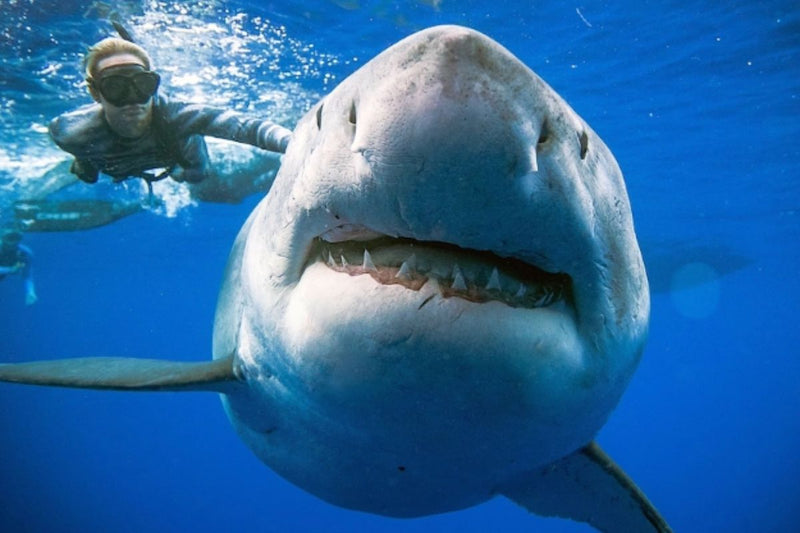Written by Stephan Aarstol
Sharks are the most feared fish that live in water all over the world. Sharks can be seen in every ocean and sometimes even in rivers and lakes. Sharks do not have bones and the structure is completely made of cartilage. The cartilage is a fibrous and tough substance that is not as hard as bones. Sharks can swim only forward and they don't have swim bladder.
Breeds/Types of Sharks
There are about 368 shark species and these are grouped together into 30 families. The sharks are differentiated based on their look and eating habit. Each family has different shapes, fins, color, sizes, personality, teeth, habitat, method of reproduction, diet, and other attributes. Some of the popular species of sharks are angel sharks, hammerhead sharks, reef sharks, blue sharks, great white sharks, and bull sharks.
What is a Shark? : General information of sharks is given in the form of FAQ.
Shark Facts : Quick facts and information on sharks.
Shark Types : Simple guide to understand different types of sharks.
Different Kinds of Sharks : Eight orders of sharks are given with clear description and examples.
The Anatomy of Sharks
Sharks have only cartilage and unlike bony fish, sharks are covered with tooth-like, smaller scales called denticles. The tails of the shark are asymmetrical and an oily liver helps in buoyancy. Sharks use advanced electroreceptive system to detect slight electrical fields. A special gill slit called spiracle is present in front of the first gill that helps in supplying oxygen directly to the brain and eyes. Sharks grow throughout their life. The sharks' teeth are modified placoid scales and they are completely replaceable.
Shark anatomy : Complete overview of shark anatomy is given is explained with a picture.
Inside Sharks : Best resource to understand skeleton, muscles, liver, respiration, and digestive tract of sharks.
Understanding Anatomy of Sharks : General sharks anatomy is explained in four divisions: head, trunk, precaudal tail, and caudal fin.
Shark Basics : Complete overview of basics of sharks is clearly explained in the form of FAQ.
Shark Teeth : A quick guide on shark teeth.
Difference between Shark and Bony Fish : Good resource to understand the difference between a shark and a bony fish.
Shark Structure : Parts of the shark is clearly explained with a neat picture.
Physiology and Biology
According to their diet, sharks are differentiated into fast moving hunters, slow moving hunters, and filter feeders. Sharks never drink water, but they absorb water through osmosis process. Most of the sharks swallow their food whole and strong acids in their stomach help to dissolve the foods completely. The female sharks are normally larger than males and the eggs are fertilized inside the female's body. The shark egg development is of many types such as viviparity, oviparity, and aplacental viviparity.
Shark Physiology : External and internal features of a shark is given.
Digestive System : Digestive system of the dogfish shark is clearly explained with neat pictures.
Chondrichthyes: Complete overview of the class Chondrichthyes is given with clear images.
Viviparous Sharks : Complete overview of viviparous sharks is given and it includes different forms of uterogestation
Virgin Birth in Sharks: Parthenogenesis in sharks is clearly explained with case studies.
Senses
Sharks have olfactory senses that easily detect even a drop of blood in the water. Some species have external barbels that help in detecting prey. Sharks have good vision even in dim light and they have a layer called tapetum lucidum at the back of the eye that increases the intensity of the incoming lights. Sharks detect electricity emitted from the living animals and even detect magnetic fields that help them to navigate. The lateral line in the sharks helps to detect vibrations or motions in water.
Sharks - Smell : Complete details of sharks sense of smell is clearly given.
Senses: Shark senses are clearly explained with pictures.
Ampullae of Lorenzini : The physiology of the Ampullae of Lorenzini in sharks is explained.
Lateral Line : A quick guide to understand the lateral line of the sharks.
Behavior
Few species of sharks are solitary hunter and few are highly social. When a shark is approached very closely they perform a threat display in the form of exaggerated swimming patterns. Normally, sharks swim at the rate of 8kms per hour, but when attacking, the shark can reach up to 19kms per hour. Sharks possess strong social skills, problem solving skills, and curiosity. Sharks use their spiracles when they rest.
Behavior: Sharks behavior in different situations is explained.
Sharks Behavior : Circling behavior of a shark around the victims is explained.
Different Behavior : Different behavior of a shark is explained with clear pictures.
Feeding and Habitat
Sharks are carnivorous and some species eat almost anything. Sharks rarely vary their diet and few species filter feed. Each shark uses different strategies to swallow foods. Most species swallow the whole food or bite food into large pieces. The social sharks like whitetip reef shark are cooperative feeders and they hunt in groups to capture the prey. Often, social sharks are migratory and travel huge distance. Sharks are normally found in seas and they do not live in freshwater except few sharks such as river shark and bull shark. Sharks are found at the depth of 2000 meters and sometimes even deeper.
Shark Habitat : Complete overview of shark habitat is clearly explained.
Shark Feeding : Good resource to understand various shark feeding methods.
Shark Habitat Studies : Habitat of different types of shark.
Eating Habits : General eating habits of sharks is given.
Shark Attacks, Predation, and Misconceptions
Only a few sharks are very dangerous to human beings. The four shark species namely oceanic whitetip, great white, bull sharks, and tiger sharks are proven to be involved in unprovoked and fatal attacks on humans. There are many misconceptions regarding sharks and the popular myth is that sharks are highly resistant to cancer and disease. The truth is sharks may get cancer and diseases affect sharks.
Sharks: Shark attacks and preventive measures are clearly explained.
Truth about Shark Attacks : Good resource to understand the truth behind shark attacks. This page clearly explains how and when shark attacks.
Shark Species in Attacks : Excellent guide on shark species that has involved in the attacks on humans.
Analysis of Shark Attacks : This paper analysis the behavior of sharks and why they attack.
Threat to Sharks
It is found that more than 100 million sharks are killed every year for recreational and commercial fishing. Sharks are also killed for shark fin soup. Harvesting sharks before they attain the sexual maturity largely affects the sharks' population. Other threats include damage, pollution, habitat alteration, loss from coastal development, and prey species.
Threats to Whale Sharks : Complete overview of threats to whale sharks.
Threats to Basking Sharks : Complete overview of threats to basking sharks.
Threats to Sharks : Different types of threats to sharks are clearly explained.
Shark Finning : Complete overview of shark finning and its effect is explained.
Fishing/Capture and Captivity
Many shark species are kept in captivity in public aquaria and only few survives in the aquarium condition. Most species are not suitable for home aquaria. Species suitable for home aquaria represent financial and spatial investment. Feeding the sharks with right amount of food is very important to avoid obesity and fast growth rates.
Pet Sharks : Good information on pet sharks is clearly given
Classification
The sharks belong to the class Chondrichthyes, superorder Selachimorpha, and subclass Elasmobranchii. All the living sharks are again split into eight orders: Squatiniformes, Pristiophoriformes, Squaliformes, Carcharhiniformes, Lamniformes, Orectolobiformes, Heterodontiformes, and Hexanchiformes.
Shark Classification : Complete overview of sharks classification and characteristics of orders of sharks is clearly given.
Comparison of Shark Orders : Shark orders are compared on the basis of body shape, dorsal fin, mouth position, reproduction, habitat, and gill slits.
Angel Sharks - Order Squatiniformes : Complete information of angel sharks is given and it includes characteristics and species.
Order Lamniformes : Complete details of the order Lamniformes and seven families in the order are explained.
Hexanchiformes: Complete overview of the order Hexanchiformes is clearly given with examples.
Here are few additional resources on sharks:
Hammerhead Sharks : A simple guide to understand hammerhead sharks.
Whale Shark - Physical Characteristics: Best source to understand whale shark's physical characteristics such as epidermis, eyes, mouth, and teeth.
Basking Shark : Biology of basking shark such as size, morphology, and coloration is explained.
Surprising Shark Facts: Interesting facts about sharks are listed.
Urogenital System : Pictures of male and female urogenital system with parts marked.
Habitat and Distribution : The habitat and distribution of great white shark is explained.
Nurse Shark : The eating habit and diet of nurse shark is given.
Thresher Shark : Size, color, features, life cycle, habitat, and diet of thresher shark is explained.
Blue Shark : Complete information on migratory patterns and habitat preferences of the blue shark.
Do Sharks Sleep? : Quick guide on sharks sleeping pattern and shark attacks.
Are all Sharks Dangerous? : Simple guide that explains different types of dangerous sharks.
Bull Shark : Complete Overview of bull shark.
Oceanic Whitetip Shark : Complete overview of oceanic whitetip shark.
Deadliest Sharks : Complete overview of top ten deadliest sharks.
Blacktip Reef Shark : Appearance, habitat, diet, and reproduction of blacktip reef shark are clearly explained.






















